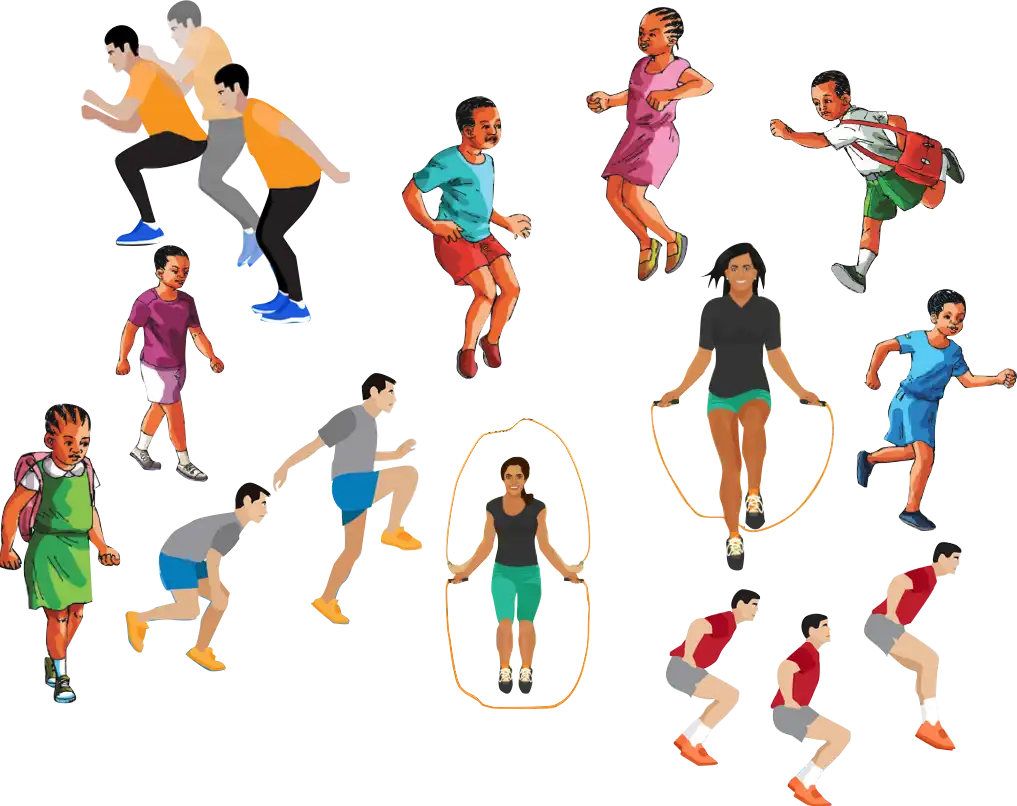Lesson Note On Moving Our Body Parts
Physical & Health Education
Theme: Fundamental movements & rhythmic activities
Topic: Locomotor movements
Sub Topic: Locomotor movements
Date: dd/mm/yyyy
Class: Basic One, Two & Three
Duration: 35 Minutes
No of Learners: 30
Learning Objectives:
By the end of the lesson learners should be able to:Describe/defined locomotor movements.
Locomotor movements are movements made from one place to another.List and demonstrate different types of locomotor movements.

- Walking: You walk by putting one foot in front of, or sometimes behind, the other. You support the body by one leg first, and then the other, swinging your arms gently as you move forward.
- Leaping: You leap by lifting yourself and land on the balls of your feet.
- Running: You run by swinging your arms fast while your legs leap one after the other.
- Skipping: An example of this is the skipping rope exercise, you spring by jumping up and down while you use the rope to circle you.
- Hopping: This is when you spring on one foot and land on the same foot.
- Sliding: An example of this is when you play on a slider, you climb up from a ladder, and slide down on the other smooth surface.
- Jumping: This is when you spring from the ground as if you are bouncing.
- Leaping: This is to spring on one foot and land on the other foot.
Rationale:
It is important to have a mature level of locomotor skills, due to the applicable nature of these skills to specific activities such as gymnastics, dance, martial arts, skating, skiing, horseback riding, track & field activities, amongst others.
Prerequisite/Previous knowledge:
Learners have learnt moving body parts.Learning Materials:
TV/VCR or DVD player, flashcards, poster or wallpaper, large open space.Reference Materials:
Physical and Health Education for Primary Schools by A. Ayegbusi et al.Lesson Development:
| STAGE | TEACHER'S ACTIVITY | LEARNER'S ACTIVITY | LEARNING POINTS |
|---|---|---|---|
| INTRODUCTION full class session (3 mins) | Teacher checks learners’ readiness and sports uniform. | Peace and values education: This is developed through following instructions and respect of game rules and safe play. |
|
| Opening discussion: (1 min) | Give learners command.
|
| Confirming the previous lesson. |
| Warm-up: 2 min | Let learners perform Warm-up exercises and stretching exercises. | Learners jogging around the ground with maintaining a medium speed for one minute, raise and rotate hands according to teacher’s signals. | Inclusive education: Allow the learner with a missing hand to use feet in the place of hands. For medium hearing disability: Be always near during instructions, use hand signs or tasking the most skilled learner to help him/her. |
| Stretching: 2 min | Ask one learner to lead single-leg hop exercises and provide support. | Learners perform general single-leg hop exercises. | |
| Development of the lesson: (15 mins) | The teacher explains to learners, we just did locomotor movements in the exercises we just performed. The Teacher may give learners a prompt (- walking, running, and jumping, we move our body from one place to another). Ask learners, what is locomotor movements? |
Learners expected to respond. Locomotor movements are movements made from one place to another. |
Developing the idea of the concept of the topic, Locomotor movements. Meaning of locomotor movements. |
| The teacher asks learners to list other types of locomotor movement exercises they can perform while moving their bodies from one place to another. The Teacher may give learners a prompt (by hopping, leaping, skipping) and get learners to discuss their views in group activities. Alternatively, the teacher may display pictures/posters of locomotor movements or pictures on learners textbook and asks learners to describe and list what they see in the pictures. 
|
Learners expected response:
|
Types of locomotor movements. | |
| Evaluation. Full class session (10 mins) | Ask the following questions to evaluate the achievement of the set objectives.
|
Learners expected response:
|
Confirming the achievement of the set objectives. |
| Conclusion, full class session (3 mins) | The teacher lets learners perform cool-down exercises. | Moves from one place to another in a different direction following instructions - forward march, turn right, turn left, back turn, ... | Communication: This is developed through answering questions verbally and interpreting of silent signs of teammates during the exercises. |
| ASSIGNMENT | The teacher gives learners a take home.
|
Learners answer other questions. | Improving their level of understanding of locomotor movements. |